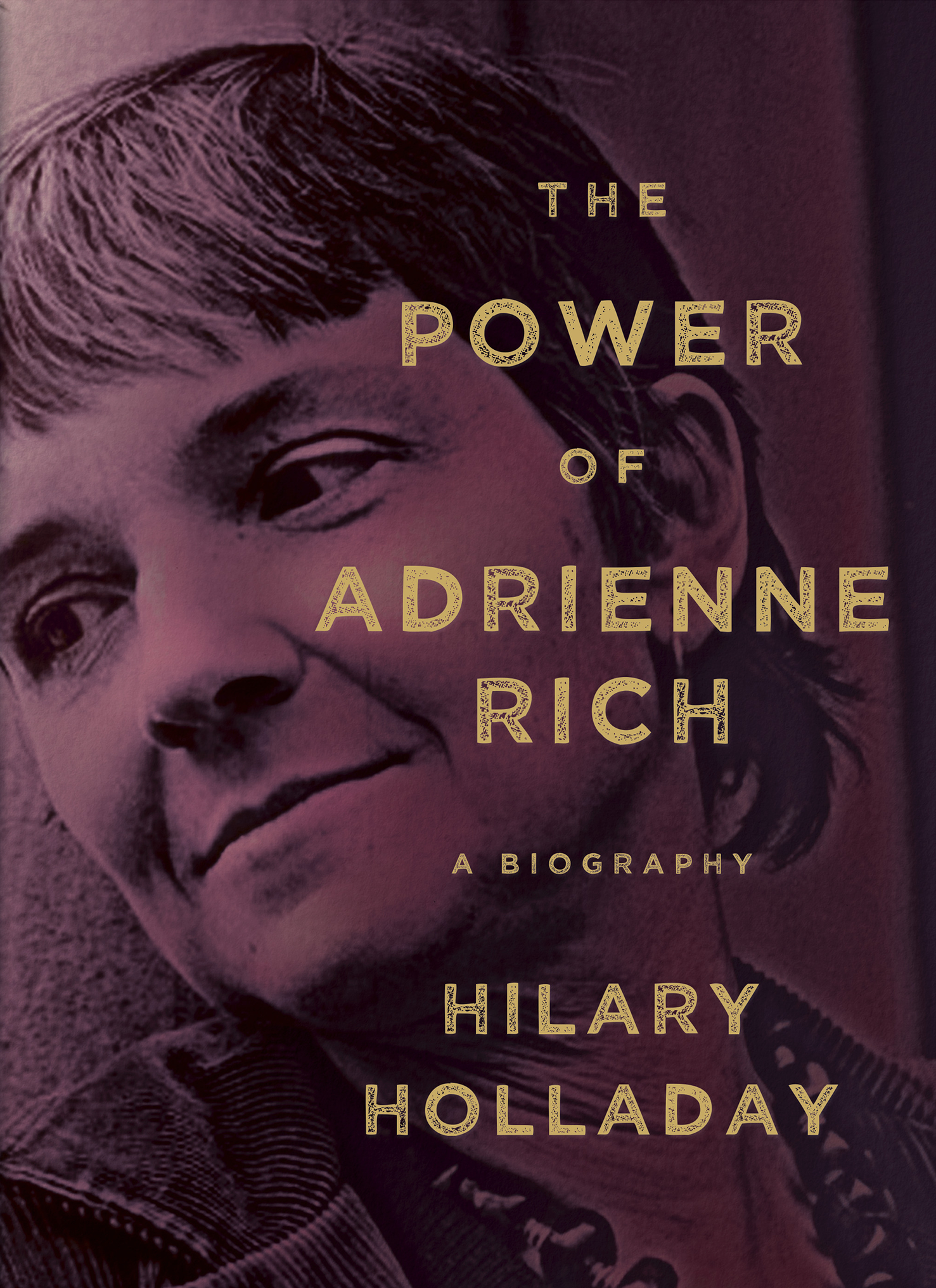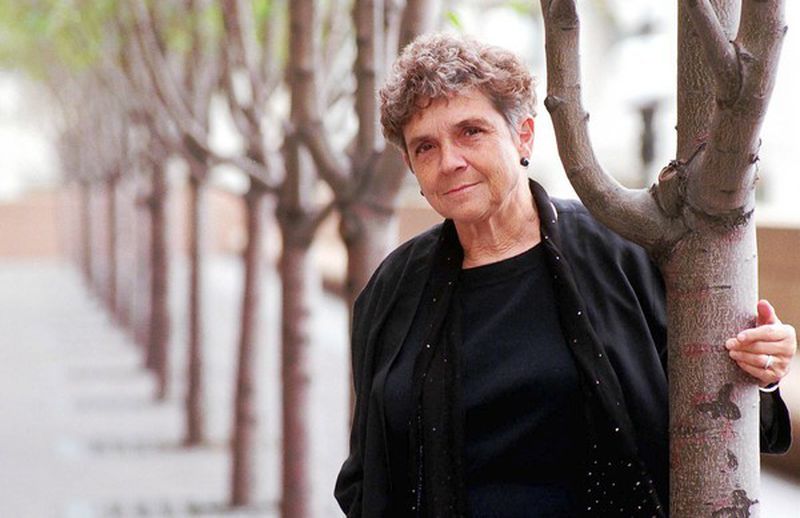 THE POWER OF ADRIENNE RICH
THE POWER OF ADRIENNE RICH
by Hilary Holladay
Nan A. Talese. 496 pages, $32.50
MY LIFE has overlapped in curious ways with that of Adrienne Rich. Both of us come from assimilated households with one Jewish parent, spent time at Harvard/Radcliffe, engaged in lesbian literary activism, and spent our later years in Santa Cruz, where I now drive daily past the street where Rich lived with her partner Michelle Cliff.
As a 59-year-old women’s history professor, I am of the generation that came of age with Rich when she was then fully established as a lesbian feminist icon whose extraordinary Dream of a Common Language, with its exquisite “Twenty-One Love Poems,” was standard reading for newly out women in bed with one another. This template for lovemaking provided not just a literature but a role model and spokeswoman with stature in the arts, inspired two generations, and influenced other artists and writers. Artist Alison Bechdel, editor Julie R. Enszer, and so many others were inspired by the lesbian journal Sinister Wisdom that Rich edited for a time.
But the Adrienne Rich who became a force in arts and letters before her emergent lesbian political identity was unknown to us. That circle has been completed by Hilary Holladay’s new biography, The Power of Adrienne Rich. Holladay reminds us to look beyond the familiar persona. Over a period of three decades, Rich evolved from a formalist poet attempting to see the world through a man’s eyes to a self-conscious female poet seeing with a woman’s eyes to a subversive essayist weighing the viability of androgyny. By the early 1980s, she was deep into an exploration of her identity as the descendent of Southerners, both Protestant and Jewish.
In her 1986 collection Blood, Bread, and Poetry: Selected Prose 1979-1985, the volume most representative of her lesbian identity politics, Rich suggested that “Few women have been in an economic position to resist marriage altogether.” Fewer still have been in an economic position to risk insulting the male literary establishment in which books are produced, read, and reviewed; all women writers have had to negotiate a cultural marriage to the mainstream marketplace of ideas. But rarest of all is the woman who removes herself from mainstream approval to reinvent her literary platform as a springboard for feminist ideals. In The Power of Adrienne Rich, Hilary Holladay invites us to explore one of feminism’s greatest conflicts: how women rely upon critical approval, success, and cultural standing in the patriarchal establishment to advance work that inveighs against patriarchy.

We observe this struggle through the life of Adrienne Rich, whose poems and essays framed a historical epoch of radical feminist imagery and language. But it is also the story of a generation of feminist writers (not by any means united or at ease with one another) who, though critical of white male power, looked to male-directed institutions like The New York Review of Books and the Modern Language Association for verification of their work’s value. From the very beginning of this compelling biography, Holladay provides the elements we need to understand Rich’s life, notably her demanding and ambitious father, who cultivated his first-born in the manner that Alissa Quart would later describe in Hothouse Kids: The Dilemma of the Gifted Child (2006). Rich’s talents gave her both empowerment and self-direction with enormously high intellectual expectations, which was complicated by the sexism for which no father prepares a daughter (such as what she encountered as an undergraduate at Radcliffe under Harvard’s giant shadow).
In the layout of Holladay’s biography, readers are able to grasp that Adrienne’s father, Arnold Rich, like so many children born in America to Jewish immigrant families, pursued assimilation to the point of silence about Judaism, piling up achievements as a bulwark against personal failure. It’s noteworthy that Adrienne Rich, born in 1929, entered adolescence just as the Holocaust was happening in Europe, a topic that was apparently never discussed at home.
One of Rich’s greatest contributions to art and politics was her reclaiming of a separate lesbian history that was rooted in the female experience and did not necessarily align with male homosexuality. In one of her most famous essays, “Compulsory Heterosexuality and Lesbian Existence” (1980), she argued that “Lesbian existence has been lived (unlike, say, Jewish or Catholic experience) without access to any knowledge of a tradition, a continuity, a social underpinning. … To equate lesbian existence with male homosexuality because each is stigmatized is to erase female reality once again.” Today, this is a viewpoint subject to intense debate in gender studies, where female essentialism is routinely portrayed as transphobic. When I taught this essay in a lesbian history seminar at George Washington University in 2015, one student responded with bewilderment: “Why didn’t these women just identify as genderqueer?” As we watch what Rich called “the social underpinning” of lesbian existence vanish inside the inclusivity of lgbtq+, the essays collected in Blood, Bread, and Poetry are well worth re-examining.
Rich’s critique of patriarchy and her involvement in lesbian separatism put her in the company of other radical women writers, including women of color who, unlike Rich, did not benefit from the white privilege of which she was so acutely aware. Holladay exposes this limitation, which appears so clearly “unwoke” from today’s vantage point, by recalling Rich’s approach to the 1974 National Book Awards. Black poets Alice Walker and Audre Lorde were, along with Rich, nominated as finalists in poetry. Rich proposed that if any of the three of them won, the winner would reject the award as patriarchal. Observes Holladay: “Her high-minded proposal carried with it a large dose of presumption: first, that she would win; second, that a joint statement from all of them was necessary; and third, that they should imperil their professional standing to validate a point she wanted to make.”
We also meet in these pages another Adrienne Rich who startled her audiences by refusing cozy membership in the institutions she once courted. “In severe, sophisticated language showing she, too, was a member of the ruling class, she socked it to the conceited male standard-bearers of the New Left and the young women in the audience whose attitudes were not so different from her own twenty years earlier. She was showing all of them what happens when a token stops laughing and starts lecturing.”
In the end, the platform of critical acclaim, literary performance, and the public limelight shaped Rich as a writer as much as she shaped the platform of white male privilege. Fans and students stand to gain a great deal from this balanced biography, which must be studied as well as read recreationally. As Holladay puts it: “She made a Talmud out of her life, the multiple meanings of which demanded endless study, debate, and interpretation.”
Bonnie J. Morris’ seventeen books include Girl Reel and The Disappearing L. She teaches women’s history at UC-Berkeley.






